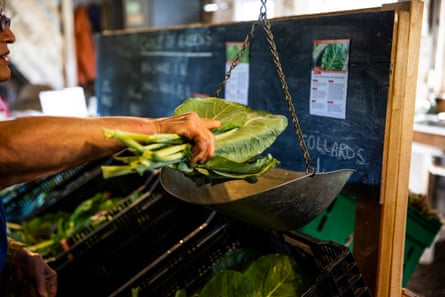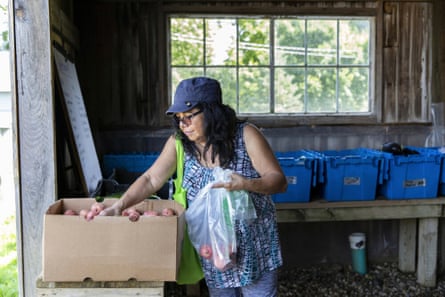HuhJust Wednesday of the growing season, Emilyn Sosa receives a box of produce from a Brooklyn community center filled with the week’s harvest. This may include carrots, beets, and sometimes kohlrabi, cooked into soups and salads for a family of five.
price? What Sosa judged fair. A 33-year-old will pay about $15 (£12) for a weekly box. If she bought the same amount of fruits and vegetables at a standard supermarket, the price is of course non-negotiable, but the cost to her could be $60 (£50) or more per week. I have.
Sosa is a member of a Community Supported Agriculture (CSA) program called Rock Steady, a 12-acre farm in upstate New York. Customers like her make regular payments to receive bundles of freshly picked fruits and vegetables. However, pricing is based on a sliding income scale, allowing customers to choose affordable payment levels. Other market farms across the country are choosing sliding scale models to reach a wider audience and help farmers survive.
Sosa doesn’t know what her fellow members chose to pay. “And it makes a big difference that it doesn’t feel like a charity,” she said.
At Rock Steady, members’ annual pricing is divided into high ($1,155), medium ($825), and low ($660) brackets based on income. In the lower bracket, about 8-9 items will set you back about $30 (£25) per week. The farm also accepts Snap cards and his EBT cards, a federal nutrition program formerly known as Food Stamps. Most people belong to the middle class, with high-income contributors subsidizing those at the bottom end of the scale.
When participating in the program, customers are asked to inventory both their physical and social circumstances in order to determine how much to pay. Do you own a home? Do you have a college education? Do you have savings? Those who do will be asked to pay a higher share. Those who are heavily in debt or rent or are elderly are encouraged to pay a lower percentage.
A 2017 survey of nearly 500 CSA farm managers nationwide found that 14% offer a subsidy program. A recent survey identified over 100 of his subsidized CSA programs.
Rock Steady introduced a subsidized model in 2015, but the Covid pandemic was a tipping point, says co-founder Maggie Chaney, who uses their/their pronouns. Pantry and grocery store lines meandering around New York City blocks was the beginning of the pandemic, according to Cheney, and as CSA’s higher-income members began donating more, so did the means. Those who didn’t could afford it. Currently, the farm’s CSAs are in high demand, with a waiting list of 200 people.
“This is not our produce donation. It is not sustainable for farmers, and in many cases they cannot even pay for it themselves,” says Cheney.
“As a queer owned and operated farm, social justice is deeply embedded in our mission,” they add. “Our drive is to feed communities that are made up of many low-income and marginalized people.”
Also in New York, but on the other side of the Hudson River, a CSA farm called the Phillies Bridge Project offers a national wage calculator to help members decide where to sit on a sliding scale. Some stocks are discounted 70% to those who qualify for Snap, which comes to about $6 a week with a small allowance for seasonal produce.
Deputy Farm Manager Rhyston Mays uses the they/them pronouns and believes it’s important to pay something, even if it’s a small amount. “Part of our honor system is building a framework that allows people to self-select and have agency as who to participate in the food system,” they say.
A study of 41 CSAs in California found that low-income subscribers were more likely to actively participate in the program than high-income subscribers, even when paying a flat fee . Those with annual incomes below her $50,000 (£41,371) were more willing to share financial risks, volunteer, and participate in farm events than those with higher incomes.

Agricultural subsidies are the only solution to the problem of reducing food inequality, says Matt Kauffman, founder of 5 Loaves, an urban farm in Buffalo. “People are not going to eat broccoli just because we serve it,” he says. “There is a cultural disconnect there.”
This is one of the shortcomings that epidemiologist and public health researcher Marilyn Sitaker identified in the sliding scale model. increase. Produce should be plentiful, accessible, culturally appropriate, and customer-preferred. “The CSA model requires a willingness to make commitments. It’s not for everyone,” she adds.
That’s why 5 Loaves runs educational programs like cooking classes and farming internships to give the community the tools to enjoy fresh produce. In Buffalo, a city with a diverse refugee and immigrant community, “maybe people want certain eggplants from Thailand or crops from East Africa,” Kaufman says. As Buffalo Farm grows, it begins to sow seeds from member cultures.
Communities can come together by “investing in the risk or reward of local farming,” says Colleen Dixon, director of Zenger Farm in Portland, Oregon. Instead of shipping out boxes of produce, fruits and vegetables are laid out on long tables each week from which CSA members are invited to pick a limited number of items.
However, there are risks associated with CSA, such as when a farm fails to produce enough crops. “Some weeks we have a big crop, and some weeks we only get a few hundred pounds of tomatoes,” says Dixon. When this happens, Zenger Farm will reimburse low-income subscribers so they can source their staples elsewhere.
Extreme weather can also disrupt crops. “When snowstorms, droughts, or fires occur, the growing season is significantly shortened, impacting food production,” Dixon says. “We expect these challenges to increase further with climate change.”
These CSA programs are far ahead of federal and state governments, Sitaker said. A National Food Strategy to fund programs that remove barriers to access to local food is just starting next year.
But Sitaker believes that sliding scale models can play a “small but mighty” role in increasing government investment to address food inequity.

